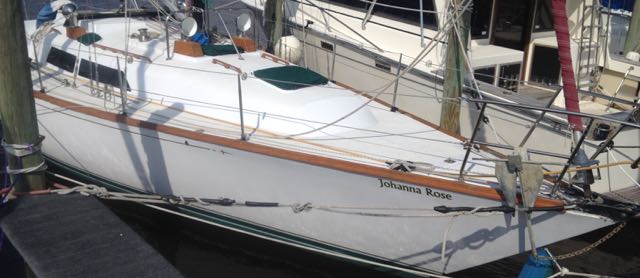This deck cleat, mounted by the mast winches, was previously screwed on the cabin top with stainless steel oval head screws. There are a few places where using screws would be acceptable, but cleats should be through bolted with proper backing plate or wide fender washer backings. This cleat was removed and the screws hole filled with thickened epoxy prior to the repainting of the deck. Below is the description of properly reinstalling the cleat with 5/16" stainless steel oval head bolts.
Preparing the bolt holes
 |
| 3/4" flat-blade wood bit |
If the deck hardware was already through bolted, but with bolt holes that exposed the core, these holes should have been prior filled with thickened epoxy along with a proper cleaning of the surfaces removing all traces of the old sealant.
If the coring is wet or rotten it should be removed by reaming the material out and letting it dry. Soaking the wet core with alcohol aids in water removal and drying. This is because both are highly soluble in one another and with a higher alcohol to water concentration the vaporization temperature of alcohol is much lower, so the alcohol/water mixture evaporates much quicker.
 |
| Over drilled holes remove core material exposing clean dry core. |
Filling the bolt holes with Epoxy
 |
| Over drilled holes wetted with epoxy. |
 |
| Over drilled holes filled with thickened epoxy. |
After the epoxy kicks and while it is still green (hard but soft tacky surface ), the top deck surface with thickened epoxy can be easily cleaned up and trimmed flush otherwise a Dremel with a sanding drum does a nice job of trimming the thickened epoxy when fully cured.
Bedding the hardware
 |
| Deck cleat properly bedded with Bostic 940FS. |
Apply sealant to the underside of the hardware and spread evenly then insert the bolts in the hardware and apply a thick ring of sealant on the top of bolt treads and underside of the hardware. Now insert all hardware bolts in the holes and simultaneously push down the hardware and bolts. Now from below, fit a backing plate or use fender washers and snug the nuts by turning the nuts only and not the bolts. Don't over tighten them. This will allow the sealant to push out and form a gasket. Over tightening is bad as it will push out too much sealant limiting proper sealing. After the sealant has partially cured, tighten down the nuts without moving the bolts. This is much easier using nuts with separate lock washers rather than the nuts with built-in nylon lock inserts (i.e. nylon lock nuts).
Now for a word on sealant. Butyl tape works well for bedding hardware, and there are many online references attesting to this. While I have used butyl for some hardware bedding, lately I have come to favor using Bostik Marine 940FS adhesive/sealant for several reasons. For one, my marina keeps it in stock at a very reasonable price. But more importantly, it has performed extremely well. It also skins over and partial cures in about 30 minutes. This allows me to bed the hardware, complete the tightening of the hardware, and clean-up with an hour.
 Here is a description of 940FS from the Bostik website:
Here is a description of 940FS from the Bostik website:
Bostik Marine 940 FS is recommended for use in bonding and sealing applications, particularly where permanent elastic bonding between surfaces is required. It can be used above and below the waterline. Its outstanding adhesion and UV resistance properties target this product for sealing deck hardware, through-hull fittings, rub-rails and portholes applications.
 |
| Newly bedded cleat in use. |





































